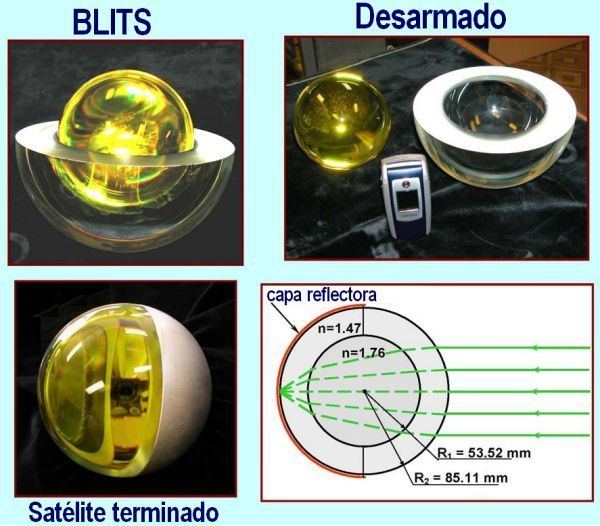Mission type Technology COSPAR ID 2009-049G Manufacturer FSUE-IPIE Inclination 98.55° Launch mass 7.53 kg Launch date 17 September 2009 | Operator RoskosmosILRS SATCAT № 35871 Inclination 98.55° Period 1.7 hours Launch mass 7.53 kg | |
 | ||
Mission duration Achieved: 3 yearsPlanned: 5 years Similar Nanosat‑1B, Progress M‑66, PharmaSat, Progress M‑MIM2, Progress M‑02M | ||
BLITS (Ball Lens In The Space) is a Russian satellite launched on September 17, 2009, as a secondary payload on a Soyuz-2.1b/Fregat, from the Baikonur Cosmodrome in Kazakhstan. The satellite is totally passive and spherical, and is tracked using satellite laser ranging by the International Laser Ranging Service. The purpose of the mission is experimental verification of the spherical glass retroreflector satellite concept as well as obtaining SLR data for solution of scientific problems in geophysics, geodynamics, and relativity . The design of BLITS is based on the optical Luneburg lens concept. The retroreflector is a multilayer glass sphere; it provides uniform reflection characteristics when viewed within a very wide range of angles, and can provide a cross-section sufficient for observations at low to medium orbit heights. A similar design was already tested on a smaller laser reflector carried on board of the METEOR-3M spacecraft launched on December 10, 2001. The satellite body consists of two outer hemispheres (radius 85.16 mm) made of a low-refraction-index glass and an inner ball lens (radius 53.52 mm) made of a high-refraction-index glass; the two outer hemispheres and the inner ball are glued together, and one of the outer hemispheres is externally coated with a reflective coating, covered with a protective varnish. The total mass is 7.53 kg. The satellite was inserted into an 832 km Sun-synchronous orbit, with an inclination of 98.85º. The satellite was spinning at a spin period of 5.6 seconds around the axis normal to its orbit plane, allowing laser light to be reflected in short bursts because only half of the satellite is covered in a reflective coating. Being the satellite made of glass, minimum in-flight slowdown of spin rate was expected, as there were no conducting parts where currents interacting with the Earth magnetic field can be induced. The expected operative life was at least 5 years, but the mission was interrupted in 2013 after a collision with space debris.
Contents
Collision
On January 28, 2013, the International Laser Ranging Service announced that a collision happened between BLITS and a space debris fragment. As a result, an abrupt change occurred of the BLITS orbit parameters (a decrease of the orbiting period) and also the spin period changed from 5.6 sec before collision to 2.1 sec after collision. On April 19, 2013 BLITS mission contacts from the Scientific Research Institute for Precision Instrument Engineering in Moscow asked the ILRS to end tracking on the satellite. According to the simulation by the Center for Space Standards & Innovation (CSSI), a research arm of Analytical Graphics, Inc. (AGI), BLITS could have been hit by a debris originated by the 2007 Chinese anti-satellite missile test.
New version
An improved version of the reflector, named BLITS-M, is scheduled for launch in 2017 with the next Gonets-M mission.
